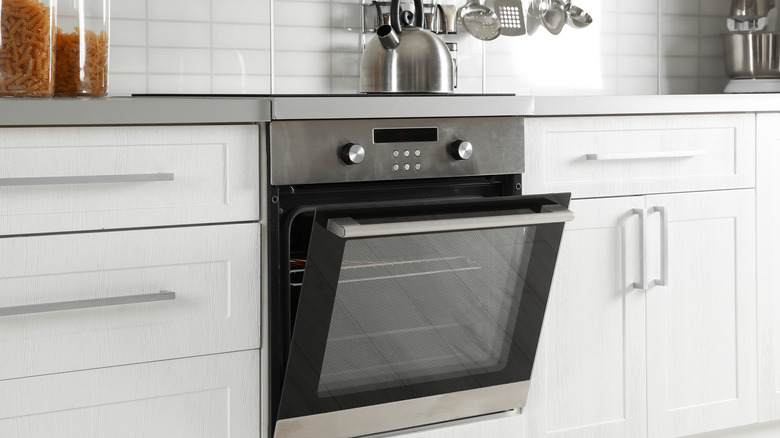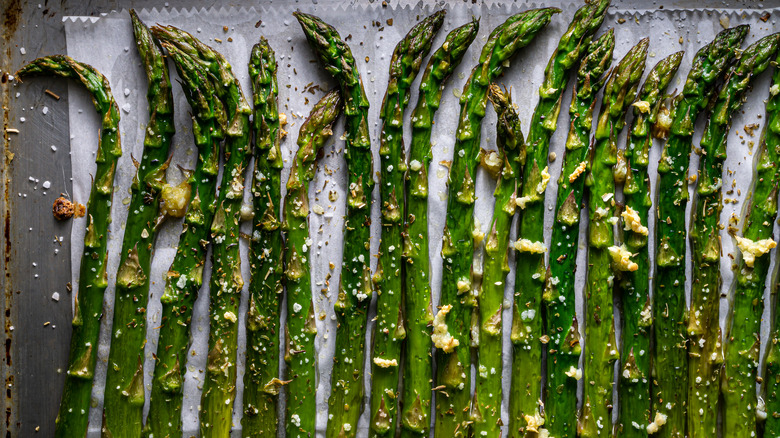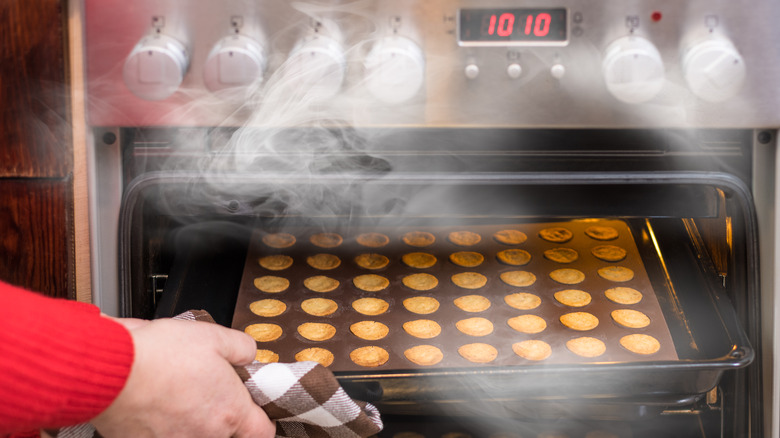The Simple Way To Adjust Recipes For A Convection Oven
Chances are, if you have a convection setting on your oven, you might not know how to use it. While the term convection carries with it an air of fancy professional kitchen lingo, it simply means that your oven has a fan (to circulate hot air) and an exhaust (which removes excess moisture from the oven). When it comes to cooking with these convection functions, it's actually quite easy to adjust your recipes to account for this extra airflow: simply lower the oven temperature or the time your food bakes.
Due to the added circulation of hot air, foods cooked in a convection oven will cook more quickly and efficiently compared to those made in a conventional oven. For this reason, you can cut down the time your roasted asparagus cooks by about a quarter of the time, which is a big deal if you've got a busy schedule and are looking for ways to save time and energy. Convection ovens also provide more energy efficiency, literally, since food surfaces heat up more quickly. So, if you have the extra time when, say you're making a pork roast, you can lower the oven temperature to ensure an even bake. For instance, if your recipe calls for 375 degrees Fahrenheit, you'll want to lower it by about 25 degrees to 350.
Convection ovens make roasted dishes with a crispy finish
Since convection ovens contain fan-exhaust systems in addition to the heating sources included in conventional ovens, they basically blow around the hot air, so they evenly cook the food and increase the surface heat of the food it touches — resulting in an extra crispy texture. This means potato wedges with a crunchy exterior and roasted broccoli that's uniformly browned on top.
Since convection is an oven setting you can switch on and off, knowing which foods to apply the cooking method to is equally as important to their required time or temperature adjustments. Convection is especially useful for roasted veggies or thick cuts of meat like lamb or poultry. Just know that when cooking meat, the outside may crisp before the inside cooking is complete, so remember to lower the time or temperature when using convection and check internal temperatures with a meat thermometer.
When it comes to baking, convection oven settings can be useful in creating bread, including sourdough loaves with crusty exteriors. Due to the thorough circulation of oven heat, many bakers love convection for making evenly golden brown batches of cookies. The main exception to cooking with convection, however, is batter-based bakes like cakes and muffins, or those with a creamy inside like custard tarts. Since convection is known for its browning and quick-cooking capabilities, baking with this setting can cause cakes or custards to form an undesirable crust and stunt the rise of a cake.
Check your oven's manual before dialing down the heat
A word of caution when choosing to lower the time or temperature using your convection oven setting: Sometimes convection ovens make temperature adjustments for you (meaning the temperature could already be 25 (or even 50 degrees) Fahrenheit lower than the temperature you dial on the oven). While this may seem sly, it's meant to help you out — especially if you're new to the oven setting. So, just check your oven's manual to see if your convection operates this way. If there's no mention of prior adjustments, you're clear to lower the temperature or check your roasted veggies for doneness a bit earlier than your recipe says.
As with any new cooking method, it's important to have an open mind and embrace a little experimentation. While cooking with convection, for instance, you'll learn that giving your veggies space to breathe (ie. not crowding the pan) is even more important than when cooking with conventional settings. Lowering the temperature and allowing for space between cubes of butternut squash will allow the circulating heat to do its work on the surface of the root veggies while cooking them evenly throughout the center.


